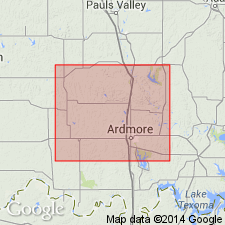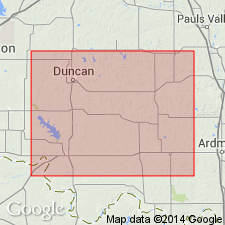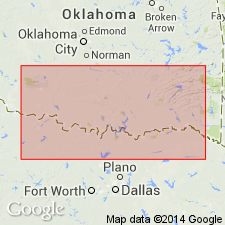
- Usage in publication:
-
- Big Branch formation
- Modifications:
-
- Original reference
- AAPG geologic province:
-
- South Oklahoma folded belt
Summary:
Big Branch formation. Divided the Pennsylvanian of Ardmore basin, Carter County, southern Oklahoma, into (descending) Pontotoc, Hoxbar, Deese, Big Branch ("to replace Goldston's Cup Coral"), and Otterville formations; and correlated the Big Branch with lower part of Cherokee and the Otterville with Morrow. This is all there is about the Big Branch formation. On p. 10 C.W. Tomlinson stated: The proposed "Big Branch" formation does not occupy stratigraphic position assigned to it by Floyd and Nufer, relative to previously named members of Dornick Hills formation. Age is Pennsylvanian.
Source: US geologic names lexicon (USGS Bull. 896, p. 181).

- Usage in publication:
-
- Big Branch Formation
- Modifications:
-
- Principal reference
- Revised
- AAPG geologic province:
-
- South Oklahoma folded belt
Summary:
Pg. 137 (fig. 2), 140-142. Big Branch Formation. Description of type locality as taken from personal communication by Nufer: 800 feet of section, lower part gray shale with one thin sand bed near middle, upper 400 feet mainly shale with sandstones, chert conglomerate, and several limestones near top of section; placed in geologic column as that unit from top of Pumpkin Creek limestone down to top of Lester limestone; fauna is Des Moines in age and has no Morrow characteristics, and should be removed from the Dornick Hills. This definition is modified by raising base of Big Branch formation from top of Lester limestone to top of Frensley limestone member of Lake Murray formation. Underlies Deese formation. Age is Middle Pennsylvanian (Des Moines).
Type locality: exposures along Big Branch of Washita River in NW/4 sec. 11, T. 3 S., R. 2 E., Carter Co., southern OK.
Source: US geologic names lexicon (USGS Bull. 1200, p. 327-328).

- Usage in publication:
-
- Big Branch formation
- Modifications:
-
- Revised
- AAPG geologic province:
-
- South Oklahoma folded belt
Summary:
Pg. 6 (fig. 2), 30. Big Branch formation. Maximum thickness about 450 feet. Includes Pumpkin Creek limestone member at top. Overlies Frensley limestone; underlies unnamed unit at base of Deese group. Age is Desmoinesian.
Source: US geologic names lexicon (USGS Bull. 1200, p. 327-328).
For more information, please contact Nancy Stamm, Geologic Names Committee Secretary.
Asterisk (*) indicates published by U.S. Geological Survey authors.
"No current usage" (†) implies that a name has been abandoned or has fallen into disuse. Former usage and, if known, replacement name given in parentheses ( ).
Slash (/) indicates name conflicts with nomenclatural guidelines (CSN, 1933; ACSN, 1961, 1970; NACSN, 1983, 2005, 2021). May be explained within brackets ([ ]).

